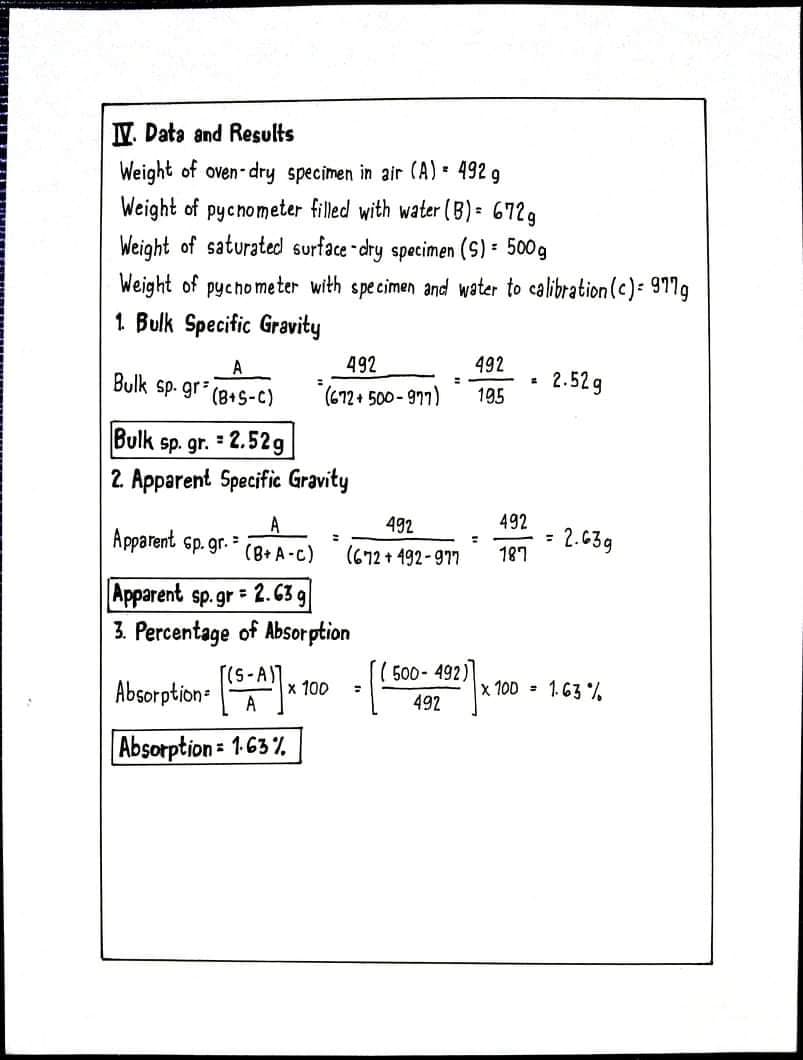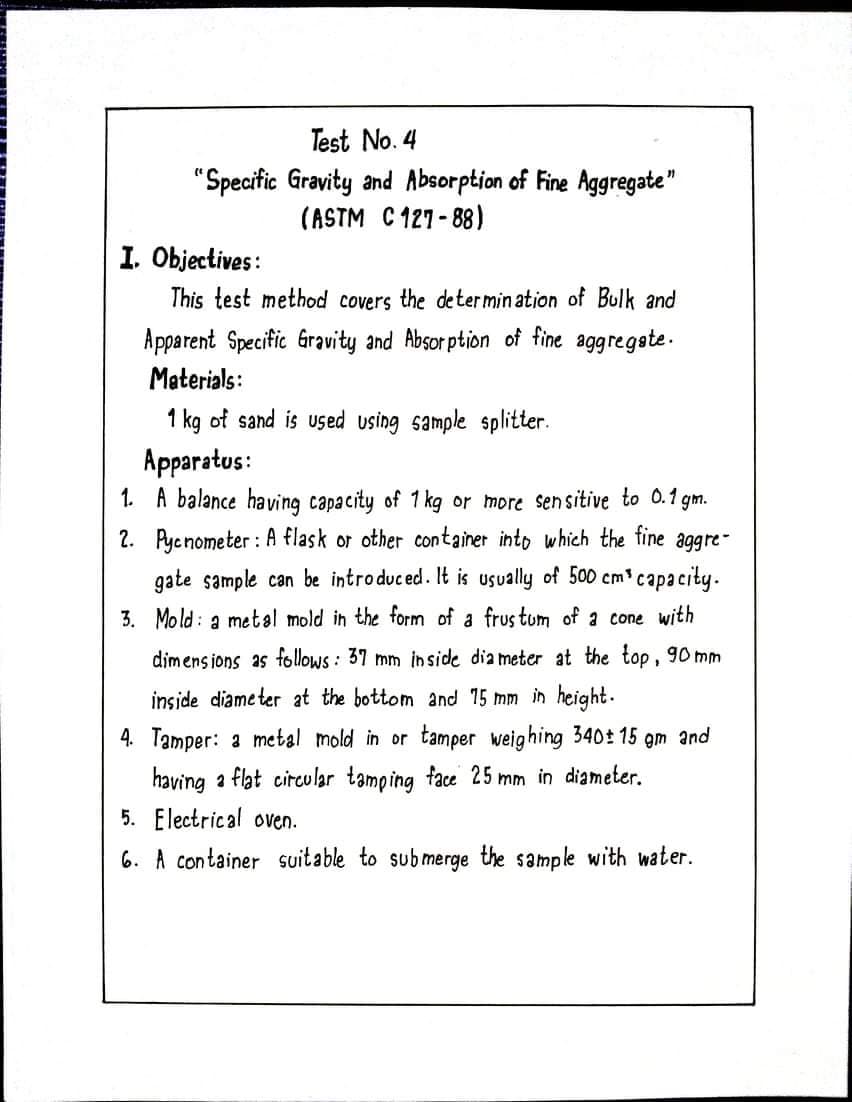Test No. 4 "Specific Gravity and Absorption of Fine Aggregate" (ASTM C 127-88) I. Objectives: This test method covers the determin ation of Bulk and Apparent Specific Gravity and Absor ption of fine aggregste. Materials: 1 kg of sand is used using sample splitter. Apparatus: 1. A balance having capacity of 1 kg or more sensitive to 0.1 gm. 2. Pyenometer : A flask or other container into which the fine aggre- gate sample can be introduced. It is usually of 500 cm'capacity. 3. Mold: a metal mold in the form of a frus tum of a cone with dimensions as follows : 37 mm inside dia meter at the top, 90 mm inside diameter at the bottom and 15 mm in height. 4. Tamper: a metal mold in or tamper weighing 340t 15 gm and having a flat circular tamping face 25 mm in diameter. 5. Electrical oven. 6. A container suitable to submerge the sample with water.
Test No. 4 "Specific Gravity and Absorption of Fine Aggregate" (ASTM C 127-88) I. Objectives: This test method covers the determin ation of Bulk and Apparent Specific Gravity and Absor ption of fine aggregste. Materials: 1 kg of sand is used using sample splitter. Apparatus: 1. A balance having capacity of 1 kg or more sensitive to 0.1 gm. 2. Pyenometer : A flask or other container into which the fine aggre- gate sample can be introduced. It is usually of 500 cm'capacity. 3. Mold: a metal mold in the form of a frus tum of a cone with dimensions as follows : 37 mm inside dia meter at the top, 90 mm inside diameter at the bottom and 15 mm in height. 4. Tamper: a metal mold in or tamper weighing 340t 15 gm and having a flat circular tamping face 25 mm in diameter. 5. Electrical oven. 6. A container suitable to submerge the sample with water.
Chapter2: Loads On Structures
Section: Chapter Questions
Problem 1P
Related questions
Question
Please answer the problem. You can summarize your answer. Thank you and Godbless.
- Comment on the results.
- Compare the results with the typical values.
- How can the percentage of absorption affect on a concrete mix?

Transcribed Image Text:V. Data and Results
Weight of oven-dry specimen in air (A) - 492 9
Weight of pychometer filled with water (B) 6729
Weight of saturated surface -dry specimen (S) 500g
Weight of pychometer with specimen and water to calibration(c)= 977g
1 Bulk Specific Gravity
492
492
Bulk sp. gr (8+S-c)
2.52 g
%3D
(672+ 500-977)
195
Bulk sp. gr. = 2.52 g
2. Apparent Specific Gravity
492
A
Apparent sp. gr. =
492
2.639
%3D
(B+ A-c)
(672 + 492-977
187
Apparent sp.gr 2. C3 g
3. Percentage of Absorption
Absorption-
[(S-A)T
x 100
( 500- 492)
x 100 = 1.63 °/,
492
Absorption= 1-63 %

Transcribed Image Text:Test No. 4
"Specific Gravity and Absorption of Fine Aggregate"
(ASTM C 127- 88)
I. Objectives:
This test method covers the determin ation of Bulk and
Apparent Specific Gravity and Absor ption of fine aggregete.
Materials:
1 kg of sand is used using sample splitter.
Apparatus:
1. A balance having capacity of 1 kg
2. Pyenometer : A flask or other container into which the fine
more sen sitive to 0.1 gm.
aggre-
gate sample can be introduced. It is usually of 500 cm' capacity.
3. Mold: a metal mold in the form of a frus tum of a cone with
dimens ions as follows : 37 mm inside dia meter at the top, 90 mm
inside diame ter at the bottom and 15 mm in height.
4. Tamper: a metal mold in or tamper weighing 340t 15 gm and
having a flat circular tamping face 25 mm in diameter.
5. Electrical oven.
6. A container suitable to submerge the sample with water.
Expert Solution
This question has been solved!
Explore an expertly crafted, step-by-step solution for a thorough understanding of key concepts.
Step by step
Solved in 2 steps

Knowledge Booster
Learn more about
Need a deep-dive on the concept behind this application? Look no further. Learn more about this topic, civil-engineering and related others by exploring similar questions and additional content below.Recommended textbooks for you


Structural Analysis (10th Edition)
Civil Engineering
ISBN:
9780134610672
Author:
Russell C. Hibbeler
Publisher:
PEARSON

Principles of Foundation Engineering (MindTap Cou…
Civil Engineering
ISBN:
9781337705028
Author:
Braja M. Das, Nagaratnam Sivakugan
Publisher:
Cengage Learning


Structural Analysis (10th Edition)
Civil Engineering
ISBN:
9780134610672
Author:
Russell C. Hibbeler
Publisher:
PEARSON

Principles of Foundation Engineering (MindTap Cou…
Civil Engineering
ISBN:
9781337705028
Author:
Braja M. Das, Nagaratnam Sivakugan
Publisher:
Cengage Learning

Fundamentals of Structural Analysis
Civil Engineering
ISBN:
9780073398006
Author:
Kenneth M. Leet Emeritus, Chia-Ming Uang, Joel Lanning
Publisher:
McGraw-Hill Education


Traffic and Highway Engineering
Civil Engineering
ISBN:
9781305156241
Author:
Garber, Nicholas J.
Publisher:
Cengage Learning